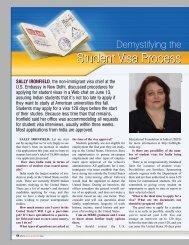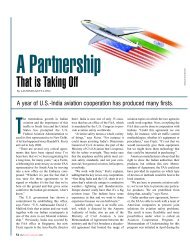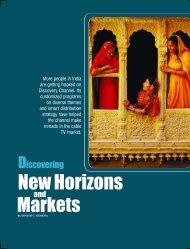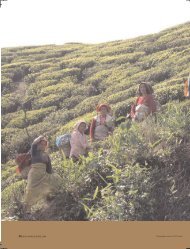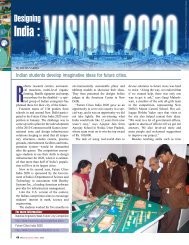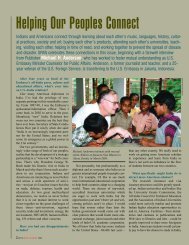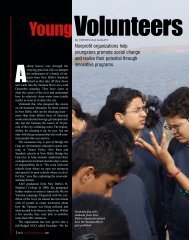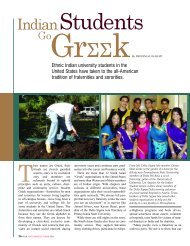Marriage Indian American Style, SPAN January/February 2008
Marriage Indian American Style, SPAN January/February 2008
Marriage Indian American Style, SPAN January/February 2008
Create successful ePaper yourself
Turn your PDF publications into a flip-book with our unique Google optimized e-Paper software.
do I even start?” he wondered. Since that<br />
awkward first encounter with <strong>Indian</strong> cuisine<br />
and overwhelming hospitality, however,<br />
he has proven himself to be a good desi<br />
by learning to eat Bengali fish dishes with<br />
his hands. “He can sail though the tricky<br />
fish dishes,” says Moni with admiration,<br />
“even the bony elish fish.”<br />
Like Kevin, Dominic also mastered the<br />
<strong>Indian</strong> art of eating without utensils.<br />
Shaista states proudly, “He does<br />
really well; instead of looking<br />
around for a hot dog and ketchup,<br />
he asks for pickle.”<br />
Biryani, kebabs, fish and<br />
masala dosa—-these are some of<br />
the <strong>American</strong>s’ favorite dishes,<br />
covering the north, south, east and<br />
west of <strong>Indian</strong> culinary culture. With<br />
practice, Ariana has become quite an<br />
<strong>Indian</strong> cook herself. “She used to measure<br />
out everything with great pains when<br />
she cooked Kerala dishes,” Sunil explained,<br />
“but now a pinch and a smidgen have<br />
become valid measuring units for her.”<br />
Cultural Blunders<br />
(A Fashion Faux Pas)<br />
Navigating <strong>Indian</strong> culture can be tricky, say<br />
the <strong>American</strong> spouses, even after studying<br />
it for many years. Sometimes the<br />
<strong>American</strong>s try too hard and err on the side<br />
of excess. When gallant, suave Sunil tied<br />
Ariana’s first sari on her, he miscalculated<br />
with some of the pins and left half of her top<br />
exposed.<br />
Sometimes these well-meaning spouses<br />
do get it right. While Dominic dances the<br />
bhangra well, Kevin is called a movie star<br />
when he dons <strong>Indian</strong> dress. And Ariana,<br />
after the initial botched attempt, is more<br />
comfortable and relaxed wearing a sari<br />
than a Western style dress, says Sunil.<br />
Baby X (And how to keep nosy<br />
neighbors guessing.)<br />
For most <strong>American</strong>s, picking a child’s<br />
name is easy because it’s a parent’s individual<br />
choice. But in mixed marriages,<br />
naming babies is half graceful art, half<br />
political compromise and no longer about<br />
advertising to the world which state, city,<br />
religion, ethnicity, class, caste, author,<br />
actor or relative the parents most identify<br />
with.<br />
For Shaista and Dominic, it was important<br />
to give their children global names, not<br />
just bicultural ones. Summer (Samar) is an<br />
Arabic name that is understood everywhere,<br />
they explained, while Sophia can be<br />
<strong>Indian</strong>, Pakistani, European or <strong>American</strong>.<br />
Holidays: Twice the Usual Fun<br />
<strong>Indian</strong> <strong>American</strong> couples tend to have<br />
double the fun when it comes to celebrating<br />
holiday traditions. “We celebrate every-<br />
VALENTINE’S DAY<br />
Contrary to popular belief, Valentine’s Day is not an <strong>American</strong> invention.<br />
The customs of exchanging romantic cards, giving flowers or sweets<br />
or taking time to express tender sentiments to one’s significant<br />
other on <strong>February</strong> 14 developed in Europe and were brought to<br />
the United States by immigrants. It is not a holiday anywhere<br />
in the United States. But woe betide any hus-<br />
Courtesy ANNE LEE SESHADRI<br />
band or boyfriend who manages to forget the<br />
day in the face of all the advertising<br />
by greeting card and candy<br />
makers, restaurants and<br />
hotels, florists and<br />
gift stores.<br />
thing!” proclaim<br />
Dominic and Shaista,<br />
pointing out that, for them,<br />
marking Eid and Christmas every<br />
year is a way to teach their children to be<br />
tolerant and free from prejudice.<br />
Ariana and Sunil made their annual<br />
Diwali party a tradition at their Northern<br />
Virginia home. Moni and Kevin celebrate<br />
Durga Puja in Atlanta, Georgia, while<br />
Anshul and Jenika enjoy celebrating<br />
Christmas, Holi and Hanukkah.<br />
Most mixed couples celebrate Christmas.<br />
“Although Christian, Peter was not used to<br />
seeing a Christmas tree,” Heather<br />
explained, “but he is patient with my<br />
<strong>American</strong> customs.” Sometimes it’s the<br />
other way around. Moni recalls her first<br />
Christmas with Kevin, “I grew up (as an<br />
<strong>Indian</strong> in America) longing to celebrate<br />
Christmas. So Kevin did all the traditional<br />
things for me that one would do for a child,<br />
from buying and decorating a tree, to giftwrapping<br />
presents—everything except<br />
Santa Claus!”<br />
Jenika makes sure that Anshul gets his<br />
own stocking and a Christmas<br />
ornament every year, along with a<br />
traditional lamb dinner that sits<br />
well with his Kashmiri heritage.<br />
Three Cheers for the Ties that<br />
Bind (And the love that<br />
endures.)<br />
When asked what they appreciate<br />
most about their spouses’ <strong>Indian</strong> culture,<br />
the <strong>American</strong>s I interviewed were<br />
unanimous: their strong sense of family.<br />
“The extended family is very strong,<br />
the togetherness,” says Dominic, whose<br />
in-laws reside with him.<br />
Moni observes: “In India, the house is<br />
open to everyone in the family.” Kevin<br />
understands the importance of family and<br />
enjoys the “family ties I have.”<br />
For all young couples, marriage to<br />
someone from another culture was as<br />
interesting as it was illuminating. And as<br />
the years go by, do the differences diminish?<br />
To answer that I had to find a couple<br />
whose marriage had withstood the test of<br />
time and distance. I found my inspiration<br />
in Ophelia and Amos Gona, she an African<br />
<strong>American</strong> professor from the southern<br />
United States, he a professor from Goa,<br />
both living in suburban New Jersey since<br />
the 1970s and now retired. When I asked<br />
Ophelia what insights she could share with<br />
<strong>SPAN</strong> readers about bridging cultural differences,<br />
she wrote: “It sounds strange, but<br />
after 46 years of marriage, I can’t think of<br />
anything I could possibly add.” I went<br />
back home and told Srikanth, and we both<br />
smiled.<br />
Anne Lee Seshadri, at left in her wedding<br />
photo with her husband, Srikanth, is an assistant<br />
cultural affairs officer at the U.S. Embassy<br />
in New Delhi.<br />
Adnan Siddiqi, the cultural affairs counselor<br />
at the U.S. Embassy, contributed to this article.<br />
Please share your views on this article. Write to<br />
editorspan@state.gov




